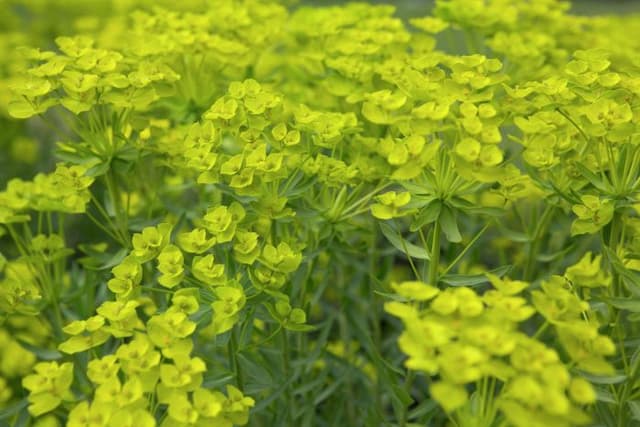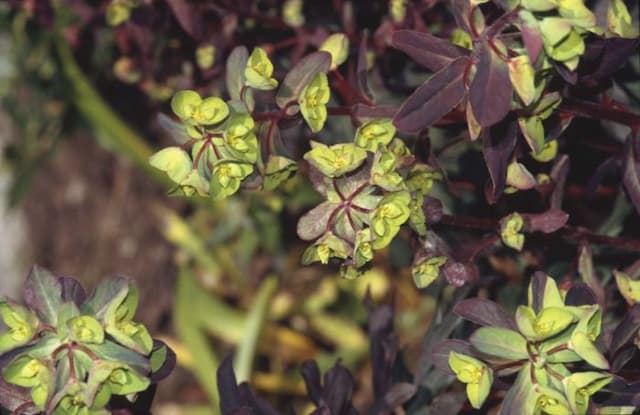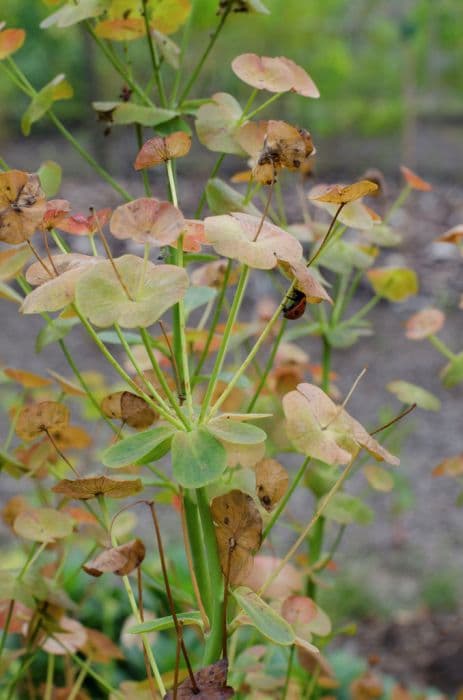Mediterranean Spurge Euphorbia characias subsp. wulfenii 'Jimmy Platt'

ABOUT
Euphorbia characias subsp. wulfenii 'Jimmy Platt', commonly known as Mediterranean Spurge, is a striking plant characterized by its dense, dome-shaped clumps of narrow, blue-green leaves that radiate out from the central stems, creating a textured and architectural appearance. This perennial offers a year-round interest with its evergreen foliage that contrasts beautifully against different backgrounds. During the blooming season, Mediterranean Spurge produces abundant clusters of bright chartreuse-yellow flowers, which are actually specialized structures called bracts that surround the true tiny flowers. These flower clusters cap the tops of the upright, unbranched stems, standing out boldly against the foliage and attracting the eyes as well as pollinators. The blooms eventually age to a cream or pale yellow, adding subtle variations to the color display. The overall structure of the plant is robust and bushy, contributing to a Mediterranean landscape aesthetic or to any garden design where form and color are highly valued.
About this plant
 Names
NamesFamily
Euphorbiaceae.
Synonyms
Mediterranean Spurge, Albanian Spurge, Wulfen's Spurge.
Common names
Euphorbia characias subsp. wulfenii 'Jimmy Platt'.
 Toxicity
ToxicityTo humans
The Mediterranean Spurge is considered toxic to humans. The milky sap contains diterpene esters which can cause skin irritation, and if ingested, the plant can cause severe stomach pain, nausea, vomiting, and diarrhea. Contact with the eyes can lead to temporary blindness. If any part of this plant is ingested, it is important to seek medical attention immediately.
To pets
The Mediterranean Spurge is also toxic to pets. Like in humans, ingestion can cause vomiting, diarrhea, and possibly more severe symptoms such as weakness or lethargy. Its sap can also cause skin and eye irritation. If a pet ingests this plant, it is crucial to contact a veterinarian as soon as possible.
 Characteristics
CharacteristicsLife cycle
Perennials
Foliage type
Evergreen
Color of leaves
Bluish-green
Flower color
Yellow-green
Height
3-4 feet (0.91-1.22 meters)
Spread
2-3 feet (0.61-0.91 meters)
Plant type
Shrub
Hardiness zones
8
Native area
Mediterranean
Benefits
 General Benefits
General Benefits- Drought Tolerance: Euphorbia characias subsp. wulfenii 'Jimmy Platt' is highly drought-tolerant, making it suitable for xeriscaping and arid climates.
- Low Maintenance: This variety requires minimal care, as it does not need frequent watering or fertilizing.
- Visual Interest: With its unique structure and striking chartreuse flowers, this plant adds an interesting visual element to gardens.
- Long Blooming Season: It has a lengthy flowering period from early spring to summer, providing prolonged color in garden spaces.
- Pest Resistance: The plant is generally resistant to pests, reducing the need for chemical treatments.
- Deer Resistance: Euphorbia is known for being deer resistant, important for gardens in areas with deer populations.
- Adaptability: It can thrive in a variety of soil types as long as there is good drainage.
- Structural Planting: The architectural form of Euphorbia makes it an excellent choice for adding structure to borders and beds.
- Erosion Control: Its robust root system can help stabilize soil and prevent erosion on slopes.
- Seasonal Interest: The foliage often takes on reddish tints in cooler weather, adding to the plant's seasonal interest.
 Medical Properties
Medical PropertiesThis plant is not used for medical purposes.
 Air-purifying Qualities
Air-purifying QualitiesThis plant is not specifically known for air purifying qualities.
 Other Uses
Other Uses- Euphorbia characias subsp. wulfenii 'Jimmy Platt' can be used as a natural barrier due to its size and structure, which can discourage foot traffic and animals from traversing certain areas of a garden, particularly due to its toxic sap.
- The sap of the Mediterranean spurge can be utilized as a fish poison; indigenous groups have historically used this method to temporarily stun fish, making them easier to catch. However, this practice is illegal in many areas and environmentally harmful.
- Dried specimens of Mediterranean spurge can be used in floral arrangements for unique and long-lasting displays.
- The architectural form of the Mediterranean spurge, with its striking vertical lines, is used in landscape design to create visual interest and contrast with rounder, softer plant forms.
- When planted in groups, the Mediterranean spurge can be used for soil erosion control on slopes due to its root system that helps to stabilize the soil.
- Extracts from the plant may serve as a natural insect repellent, but care must be taken due to the toxicity of the sap to humans and animals.
- Used in photography and botanical illustration, Mediterranean spurge's unique appearance adds an exotic touch to artistic compositions.
- With its dramatic seasonal changes, including vibrant green in spring and summer, Mediterranean spurge can be planted in educational gardens to help demonstrate plant life cycles and seasonal adaptations.
- Mediterranean spurge can be used in conjunction with other drought-tolerant plants in water conservation landscapes or xeriscaping due to its low water requirements once established.
- Its unique textural qualities make Mediterranean spurge a candidate for tactile garden experiences designed for the visually impaired.
Interesting Facts
 Feng Shui
Feng ShuiThe Mediterranean Spurge is not used in Feng Shui practice.
 Plant Symbolism
Plant Symbolism- Resilience: Mediterranean Spurge, as a hardy plant often found in dry and rocky conditions, symbolizes the ability to thrive in difficult environments and overcome adversity.
- Protection: With its toxic sap, Mediterranean Spurge has a symbolic association with defense and protection against external threats.
- Healing: Historically, members of the Euphorbia genus have been used for medicinal purposes, which lends this plant a symbolic meaning of healing and relief.
 Water
WaterThe Mediterranean Spurge needs moderate watering, generally about 1 gallon per week for an established plant, though this will vary based on local climate conditions. During hot and dry periods, it may require water twice a week, while in cooler, wetter climates or seasons, watering can be reduced. Always allow the soil to dry out between waterings to prevent root rot. It's important to avoid overwatering as the plant is drought-tolerant and prefers a well-draining soil setup.
 Light
LightMediterranean Spurge thrives in full sun to partial shade conditions. For optimal growth, place the plant in a spot where it can receive at least 6 hours of direct sunlight per day. Too little light can lead to leggy growth and fewer flowers, so a south-facing or west-facing location is usually ideal for this plant.
 Temperature
TemperatureMediterranean Spurge is cold-hardy and can withstand temperatures down to about 20°F, while the high end of its tolerance is around 90°F. It prefers to grow in a temperate climate with an ideal range between 50°F and 80°F. While it can survive a frost, it's best to protect the plant if a deep freeze is expected.
 Pruning
PruningPrune the Mediterranean Spurge after flowering to maintain its shape and encourage new growth. Typically, this is done in late summer or fall. The plant will benefit from cutting back any spent flower stalks and removing damaged or yellowing leaves to promote a tidy appearance and prevent disease.
 Cleaning
CleaningAs needed
 Soil
SoilMediterranean Spurge requires well-draining soil with a mixture of sand, compost, and a small amount of peat for acidity. An optimal soil pH for this plant is slightly alkaline, around 7.5 to 8.0.
 Repotting
RepottingMediterranean Spurge typically doesn't need regular repotting. It should be repotted only when it outgrows its container, which is usually every 2-3 years.
 Humidity & Misting
Humidity & MistingMediterranean Spurge is tolerant of dry air and prefers low to average humidity levels, mimicking its native Mediterranean environment.
 Suitable locations
Suitable locationsIndoor
Place in bright light, limit watering, and provide good air circulation.
Outdoor
Full sun, well-drained soil, shelter from cold winds.
Hardiness zone
7-10 USDA.
 Life cycle
Life cycleEuphorbia characias subsp. wulfenii 'Jimmy Platt', also known as Mediterranean Spurge, begins its life as a seed which germinates in warm, well-drained soil, typically in spring or early summer. The seedling develops into a robust, evergreen perennial plant with upright stems and blue-green leaves. Over time, the plant forms a bushy clump, reaching maturity at 1 to 1.5 meters tall and wide, and produces characteristic greenish-yellow flower bracts. These bracts appear in late winter to early spring and attract pollinators to the plant. After pollination, the plant produces seed capsules that burst open when ripe, dispersing seeds for the next generation. The plant typically has a lifespan of several years but may become woody at the base as it ages, requiring rejuvenation by cutting back or division.
 Propogation
PropogationPropogation time
Early Spring
Propogation: The most popular method of propagating Euphorbia characias subsp. wulfenii 'Jimmy Platt', commonly known as Mediterranean Spurge, is through cuttings. Propagation is best done in late spring or early summer when the plant is actively growing. You should use a sharp, clean knife or pruners to take a cutting of about 6 inches (15 centimeters). It's crucial to allow the cutting to dry and form a callus for about a week before planting it to avoid rot. Once callused, the cutting can be placed in a well-draining soil mix. Rooting hormone can be used to enhance root development, though it's not always necessary. Keep the soil slightly moist but not waterlogged, and in a warm, bright environment, roots should begin to form within a few weeks.









